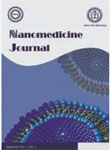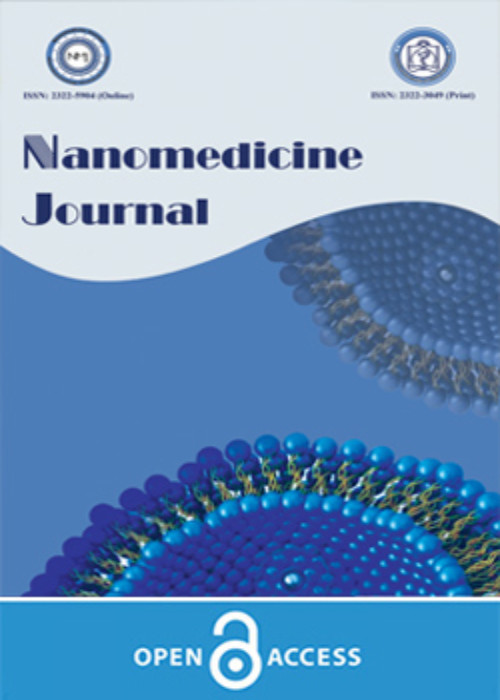فهرست مطالب

Nanomedicine Journal
Volume:1 Issue: 2, Winter 2014
- تاریخ انتشار: 1392/07/05
- تعداد عناوین: 8
-
-
Pages 63-70Objective(s)Electromagnetic radiations which have lethal effects on the living cells are currently also considered as a disinfective physical agent.Materials And MethodsIn this investigation, silver nanoparticles were applied to enhance the lethal action of low powers (100 and 180 W) of 2450 MHZ electromagnetic radiation especially against Escherichia coli ATCC 8739. Silver nanoparticles were biologically prepared and used for next experiments. Sterile normal saline solution was prepared and supplemented by silver nanoparticles to reach the sub-inhibitory concentration (6.25 μg/mL). Such diluted silver colloid as well as free-silver nanoparticles solution was inoculated along with test microorganisms, particularly E. coli. These suspensions were separately treated by 2450 MHz electromagnetic radiation for different time intervals in a microwave oven operated at low powers (100 W and 180 W). The viable counts of bacteria before and after each radiation time were determined by colony-forming unit (CFU) method.ResultsResults showed that the addition of silver nanoparticles significantly decreased the required radiation time to kill vegetative forms of microorganisms. However, these nanoparticles had no combined effect with low power electromagnetic radiation when used against Bacillus subtilis spores.ConclusionThe cumulative effect of silver nanoparticles and low powers electromagnetic radiation may be useful in medical centers to reduce contamination in polluted derange and liquid wastes materials and some devices.Keywords: electromagnetic radiation, Silver nanoparticles, disinfection process, combined effect *Corresponding
-
Pages 71-78Objective(s)This paper describes coating of magnetite nanoparticles (MNPs) with amorphous silica shells.Materials And MethodsFirst, magnetite (Fe3O4) NPs were synthesized by co-precipitation method and then treated with stabilizer molecule of trisodium citrate to enhance their dispersibility. Afterwards, coating with silica was carried out via a sol-gel approach in which the electrostatically stabilized MNPs were used as seeds. The samples were characterized by means of X-ray diffraction (XRD), transmission electron microscopy (TEM), Fourier transform infrared (FT-IR) spectroscopy and vibrating sample magnetometer (VSM).ResultsThe results of XRD analysis implied that the prepared nanocomposite consists of two compounds of crystalline magnetite and amorphous silica that formation of their core/shell structure with the shell thickness of about 5 nm was confirmed by TEM images. The magnetic studies also indicated that produced Fe3O4@SiO2 core/shell nanocomposite exhibits superparamagnetic properties at room temperature.ConclusionThese core/shell structure due to having superparamagnetic property of Fe3O4 and unique properties of SiO2, offers a high potential for many biomedical applications.Keywords: Magnetite, Silica, Core, shell structure, Superparamagnetism, Biomedical applications
-
Pages 79-87Objective(s)This study aimed to find the effects of silver nanoparticles (Ag-NPs) (40 nm) on skin wound healing in mice Mus musculus when innate immune system has been suppressed.Materials And MethodsA group of 50 BALB/c mice of about 8 weeks (weighting 24.2±3.0 g) were randomly divided into two groups: Ag-NPs and control group, each with 25 mice. Once a day at the same time, a volume of 50 microliters from the nanosilver solution (10ppm) was applied to the wound bed in the Ag-NPs group while in the untreated (control) group no nanosilver solution was used but the wound area was washed by a physiological solution. The experiment lasted for 14. Transforming growth factor beta (TGF-β), complement component C3, and two other immune system factors involving in inflammation, namely C-reactive protein (CRP) and rheumatoid factor (RF) in sera of both groups were assessed and then confirmed by complement CH50 level of the blood.ResultsThe results show that wound healing is a complex process involving coordinated interactions between diverse immunological and biological systems and that Ag-NPs significantly accelerated wound healing and reduce scar appearance through suppression of immune system as indicated by decreasing levels of all inflammatory factors measured in this study.ConclusionExposure of mice to Ag-NPs can result in significant changes in innate immune function at the molecular levels. The study improves our understanding of nanoparticle interaction with components of the immune system and suggests that Ag-NPs have strong anti-inflammatory effects on skin wound healing and reduce scarring.Keywords: Silver nanoparticles (Ag, NPs), Skin wound, Innate immune system, Mus musculus
-
Pages 88-93Objective (s): A simple and «green» method was developed for preparing zinc oxide nanoparticles (ZnO-NPs) in aqueous starch solutions. Starch was used as a stabilizer to control of the mobility of zinc cations and then control growth of ZnO-NPs prepared via a sol-gel method. Because of the special structure of the starch, it permits termination of the particle growth.Materials And MethodsThe dried gel was calcined at different temperatures of 400, 500, 600, and 700 °C. The prepared ZnO-NPs were characterized by different techniques such as X-ray diffraction analysis (XRD), transmittance electron microscopy (TEM), and UV-Vis absorption.ResultsThe XRD results displayed hexagonal (wurtzite) crystalline structure for prepared ZnO nanoparticles with mean sizes below than 50 nm. In vitro cytotoxicity studies on neuro2A cells showed a dose dependent toxicity with non-toxic effect of concentration below 6 μg/mL.DiscussionThe results showed that starch is an eco-friendly material that can be used as a stabilizing agent in the sol-gel technique for preparing of ZnO-NPs in a large scale.
-
Pages 94-99Objective(s)To evaluate the influences of aqueous extracts of plant parts (stem, leaves, and root) of Portulaca oleracea L. on bioformation of silver nanoparticles (AgNPs).Materials And MethodsSynthesis of silver nanoparticles by different plant part extracts of Portulaca oleracea L. was carried out and formation of nanoparticles were confirmed and evaluated using UV-Visible spectroscopy and AFM.ResultsThe plant extracts exposed with silver nitrate showed gradual change in color of the extract from yellow to dark brown. Different silver nanoperticles were formed using extracts of different plant parts.ConclusionIt seems that the plant parts differ in their ability to act as a reducing and capping agent.Keywords: Nanoparticles, Silver, Portulaca oleracea, Plant part
-
Pages 100-106Objective(s)This paper describes a selective and sensitive biosensor based on the dissolution and aggregation of aptamer wrapped single-walled carbon nanotubes. We report on the direct detection of aptamer–cocaine interactions, namely between a DNA aptamer and cocaine molecules based on near-infrared absorption at 807 .Materials And MethodsFirst a DNA aptamer recognizing cocaine was non-covalently immobilized on the surface of single walled carbon nanotubes and consequently dissolution of SWNTs was occurred. Vis-NIR absorption (A807nm) of dispersed, soluble aptamer-SWNTs hybrid, before and after incubation with cocaine was measured using a CECIL9000 spectrophotometer.ResultsThis carbon nanotube setup enabled the reliable monitoring of the interaction of cocaine with its cognate aptamer by aggregation of SWNTs in the presence of cocaine. Disscusion: This assay system provides a mean for the label-free, concentration-dependent, and selective detection of cocaine with an observed detection limit of 49.5 nM.Keywords: Aptamer, Cocaine, Single, walled carbon nanotube, Near infrared absorption
-
Pages 107-111Objective(s)The aim of this study was to synthesis new dental nanocomposites reinforced with fabricated glass nanoparticles and compare two methods for fabrication and investigate the effect of this filler on mechanical properties.Materials And MethodsThe glass nanoparticles were produced by wet milling process. The particle size and shape was achieved using PSA and SEM. Glass nanoparticles surface was modified with MPTMS silane. The composite was prepared by mixing these silane-treated nanoparticles with monomers. The resin composition was UDMA /TEGDMA (70/30 weight ratio). Three composites were developed with 5, 7.5 and 10 wt% glass fillers in each group. Two preparation methods were used, in dispersion in solvent method (group D) glass nanoparticles were sonically dispersed in acetone and the solution was added to resin, then acetone was evaporated. In non-dispersion in solvent method (group N) the glass nanoparticles were directly added to resin. Mechanical properties were investigated included flexural strength, flexural modulus and Vickers hardness.ResultsHigher volume of glass nanoparticles improves mechanical properties of composite. Group D has batter mechanical properties than group N. Flexural strength of composite with 10%w filler of group D was 75Mpa against 59 Mpa of the composite with the same filler content of group N. The flexural modulus and hardness of group D is more than group N.ConclusionIt can be concluded that dispersion in solvent method is the best way to fabricate nanocomposites and glass nanoparticles is a significant filler to improve mechanical properties of dental nanocomposite.Keywords: Glass nanoparticles, Dispersion, ö öDental nanocomposites, Mechanical properties
-
Pages 112-120Objective(s)The purpose of the present study was to prepare and to evaluate a novel niosome as transdermal drug delivery system for propranolol hydrochloride and to compare the in vitro efficiency of niosome by either thin film hydration or hand shaking method.Materials And MethodsNiosomes were prepared by Thin Film Hydration (TFH) or Hand Shaking (HS) method. Propranolol niosomes were prepared using different surfactants (span20, 80) ratios and a constant cholesterol concentration. In vitro characterization of niosomes included microscopical observation, size distribution, laser light scattering evaluation, stability of propranolol niosomes and permeability of formulations in phosphate buffer (pH=7) through rat abdominal skin.ResultsThe percentage of entrapment efficiency (%EE) increased with increase in surfactant concentration in all formulations. Among them, F3 formulation (containing span80:cholesterol ratio of 3:1) showed the highest entrapment efficiency (86.74±2.01%), Jss (6.33μg/cm2.h) and permeability coefficient (. By increasing the percentage of entrapment efficiency (resulting in increase in surfactant concentration), the drug released time is not prolonged. Among all the formulations, F4 needed more time for maximum drug release. Among these formulations, F4 was also found to have the maximum vesicle size as compared to other formulations. It was observed that niosomal suspension prepared from span 80 was more stable than span 20.ConclusionThis study demonstrates that niosomal formulations may offer a promise transdermal delivery of propranolol which improves drug efficiency and can be used for controlled delivery of propranolol


